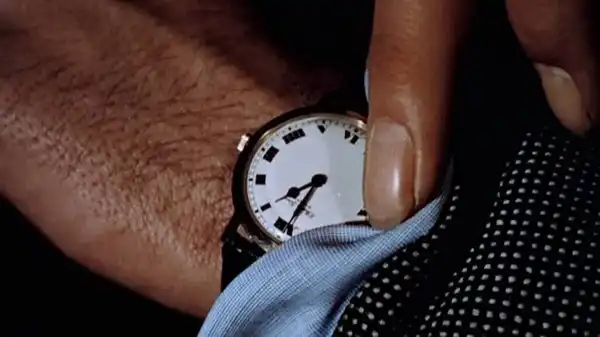
Save this storySave this storySave this storySave this story
“Clock,” a mesmerizing work by Swiss artist Christian Marclay, has been on display at MOMA since November, and many of us have become avid watch lovers, returning again and again to see as much of the time as possible. As the exhibition approaches its end on May 11, the thought of life without a watch is reminiscent of losing a beloved mechanical timepiece from your wrist, or losing the sense of time.
As my colleague Daniel Zalewski noted more than a decade ago in his Profile of the Artist, The Clock is as simple in conception as it is majestic in scale. Over the course of a century, Marclay and his team of dedicated collaborators collected moments from films and television shows where clocks tell (or hint at) the time of day. Marclay then edited this archive—more than ten thousand clips, capturing all (or nearly all) of the fourteen hundred and forty minutes of a day—into a film that unfolds in perfect synchrony with time itself, projected on a perpetual twenty-hour cycle. It is both a cinematic collage and an actual clock, a kind of clock that tells the current time, day or night, whether the museum is open or not.
To describe the work in this way is to make it sound intrusive but not necessarily engaging—something that, like much video art, can be looked at for a few dozing minutes and then forgotten. But what’s most extraordinary about this long work is that, despite its sources, it’s so compelling. People come expecting to spend, say, half an hour, and end up staying for hours. And it’s not just a bunch of avant-garde artists who are lingering: when the museum stayed open all night, offering a rare chance to see the work in its entirety, including the usually hidden night and early morning hours, tickets for late-night entry were so sought after that people would start lining up at five-thirty in the morning (to register at eight-thirty). Those of us who showed up at the seemingly impossible hour of seven went home disappointed.
On one level, the film offers a comic commentary on the repetition of certain dramatic devices over the years. Marclay himself admitted as much to Zalewski: “You begin to understand how a film is made, from these devices and tropes that they constantly use. For example, if someone turns sharply, you expect that in the next shot it will be someone else. The actor looks at his watch, and suddenly you see a close-up of the watch.” Filmmaking, we are reminded, habitually and predictably groups its effects around key times: noon is, of course, the time of “noon,” when duels take place, and when bank robberies and bombs often go off.
But what makes The Clock such a remarkable work of art is the ingenious subtlety with which the old clips are strung together. As with the birds in Audubon’s ornithological books, the simple additive intensity is compelling as minute piles up on minute. Even the most unremarkable manifestations of time—an actor staring at his watch—can be fascinating when catalogued. Watching time pass can be fascinating in itself, whether on the face of Big Ben—whose many appearances, often in early Hitchcock black and white, make it one of the characters—or heard in a snatch of dialogue (“Jesus! It’s eight-fifteen! We’d better be going”). The traditionally dramatic moments of the day, noon and midnight, are intertwined with the silent, inglorious ones—two thirty-one, eleven thirty-two—all glued together forever.
True to his relentless minute-long mission, Marclay assembles small suites of overlapping actions, each lasting about ten minutes. Themes and characters return. In the half-hour after 7:35 p.m., we witness three James Bonds (Sean Connery, Daniel Craig, and Roger Moore) grappling with various Bond dilemmas in the twilight: Connery in Dr. No, brooding in his Jamaican hotel room; Craig in Casino Royale, trying on a new tuxedo before a late-night poker game; and Moore in Moonraker, throwing a kung-fu-savvy Asian villain out of the glass facade of the great clock in Venice’s Piazza San Marco—a neat aggregation of Bond styles, from the straightforward to the slightly mannered and hyper-mannered. Shortly after nine in the morning, we see Cary Grant, and within a couple of minutes he is simultaneously ingratiatingly seducing Ingrid Bergman over the phone in Indiscreet and, disguised as a bellhop, stepping off the morning train in North by Northwest.
Other moments unfold quietly: in several passages between 9 a.m. and noon, Susan Hayward in I Want to Live! awaits the gas chamber and is eventually executed. Others are sweet jokes for those who love cinema: at 9:13 a.m., there is an unusually long scene of a shy post-wedding breakfast in New York between Judy Garland and Robert Walker.
Sourse: newyorker.com